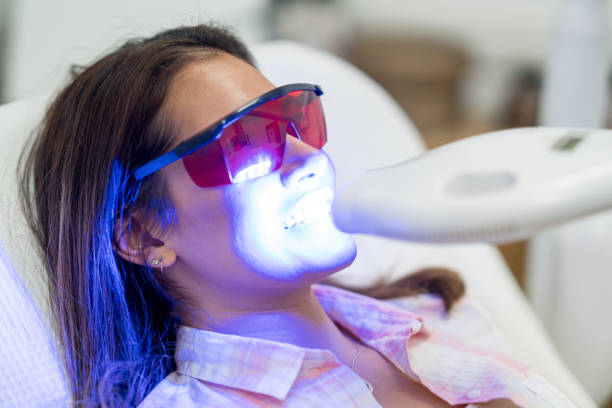Table of Contents
Teeth Whitening Service
Teeth whitening is an excellent, safe, cost-effective way to achieve a brighter smile.
Some methods used to brighten teeth and reduce surface stains include at-home whitening products such as strips and gels, as well as dental office procedures such as chairside bleaching.
Whatever method of tooth whitening you use, it will not last indefinitely. At-home products may produce minor to significant results that last for a few months. Professional dental procedures may allow you to extend that time by up to 2-3 years.
Intrinsic stains vs. extrinsic stains
Tooth stains come in two varieties:
Intrinsic stains; Caused by aging, trauma, infection, and medication. These deep, internal stains are more difficult to remove, but they can be removed with the right treatment.
Extrinsic Stains; brought on by food, alcohol, and cigarette smoke. The majority of whiteners remove external stains.
The most well-liked whitening procedures are listed below, along with how long they last:
- Whitening Toothpaste
It could take two to six weeks to see any improvements from whitening toothpaste twice daily. According to users, these results can last up to three or four months.
You can use a whitening toothpaste daily or several times each week. They include substances that polish or whiten teeth, including:
Moderate abrasives like hydrogen peroxide and carbamide peroxide
- Whitening Mouthwash
In most cases, hydrogen peroxide is found in whitening mouthwashes. To assist in erasing minor surface stains, you might use a whitening mouthwash every day.
Before you notice any effects from a whitening mouthwash, it could take up to three months.
Using whitening mouthwash to extend the effects of other treatments, including in-office whitening or whitening strips, may be the most effective strategy. It does not have strong or protracted effects when used alone.
- Whitening strips
The number of applications necessary to observe results with whitening strips varies. Some strips offer superior results, which may last up to six months.
One of the most effective over-the-counter methods for at-home tooth whitening is using whitening strips. More user-friendly and efficient than other are certain brands. To offer more intense stain removal, some people employ LED accelerator lights.
Peroxide is used in whitening strips to whiten teeth and eliminate stains. They could be painful or damaging to teeth if worn improperly or too frequently.
When it comes to bleaching teeth to make them whiter in colour, high-quality whitening strips can effectively eliminate extrinsic and minor intrinsic stains when used as directed.
- Whitening pens
Whitening pens might take anything from two days to a week. They offer meagre results that are frequently short-lived.
Spot stain removal is done with whitening pens, and portable little plastic tubes containing whitening gel. For roughly an hour after application, you cannot eat, drink, or brush your teeth since the gel readily washes away.
- Gel trays for at-home whitening
A whitening gel tray should start working in about a week, and the best results should appear in 2 to 4 weeks. Depending on the concentration of peroxide used and the duration of time-worn, you may notice varying degrees of whitening.
When used alongside good oral hygiene, at-home, dentist-supervised whitening gel trays should produce benefits that persist for at least a year.
Your dentist can create a tray that fits your mouth perfectly and that you fill at home with whitening gel. The bleaching agent provided by your dentist is more potent than the one in over-the-counter remedies.
Your dentist will oversee this procedure and advise you on how frequently and for how long you should use it. You might occasionally need to wear the tray overnight or for several hours each day for a week or longer.
- Chair-side whitening (in-office tooth whitening)
A chairside (or in-office) procedure should deliver long-lasting effects for 1 to 3 years if you practice appropriate oral hygiene.
This technique is carried out in the dental clinic. Typically, just one visit is necessary.
Strong bleaching agents, like carbamide peroxide or hydrogen peroxide with a high concentration, are used in this method. The bleaching agent can also be accelerated using heat or light.
Do teeth whitening side effects exist?
Teeth and gums may become sensitive due to the active ingredients in tooth whiteners. Usually, this doesn’t last very long. Long-term use of any bleaching agent containing peroxide or abrasives can be uncomfortable for certain people.
Additionally, there is a chance for more severe side effects, such as:
- Gum burns and irritation can be prevented by completely covering the gums before treatment and using custom-fitted whitening trays. This is more likely to happen when using gel trays at home or in a chair. Gum burns and irritations are often minor and transient when they do happen.
- Gum whitening: The gums may get bleached and temporarily lose their colour.
- Gastrointestinal irritation or distress: If you ingest a whitening agent, you can get a moderate stomachache or a burning sensation in your throat.
- Dentin or enamel damage: There is conflicting evidence on this. Any whitener that involves potent bleaching agents or abrasives can lead to surface grooves on teeth and thinning enamel.
During or after teeth whitening, some individuals complain of tooth pain. Call your dentist if you feel intense sensitivity, burning, or discomfort.
In some cases, the bleaching agent may penetrate a cavity or broken tooth, resulting in excruciating pain and necessitating a trip to the dentist.
Why do my teeth have a tan colour?
Teeth can turn yellow or gray with time for a variety of reasons, including:
- What you consume and ingest.
- Vaping or smoking cigarettes.
- Age and genetic influences.
- When administered as a youngster, drugs like tetracycline can leave persistent stains when the permanent teeth are growing.
- Teeth can become yellow, blue, or gray due to trauma or infection.
Is it safe teeth whitening?
In essence? Yes. However, it’s better to speak with your dentist first.
Do your front teeth have crowns or fillings?
This is the tricky part of whitening! Before whitening, discuss the best ways to get a whiter smile with your dentist in order to ensure that your restorations match the color of your natural teeth.
Professional teeth whitening service is provided at Advanced White Teeth Whitening Toronto, Richmond Hill, Markham, Mississauga, and Brampton locations.
SPECIAL: $149 to $179 Full-One-Hour Teeth Whitening In-Clinic Treatment.
Comments are closed.





